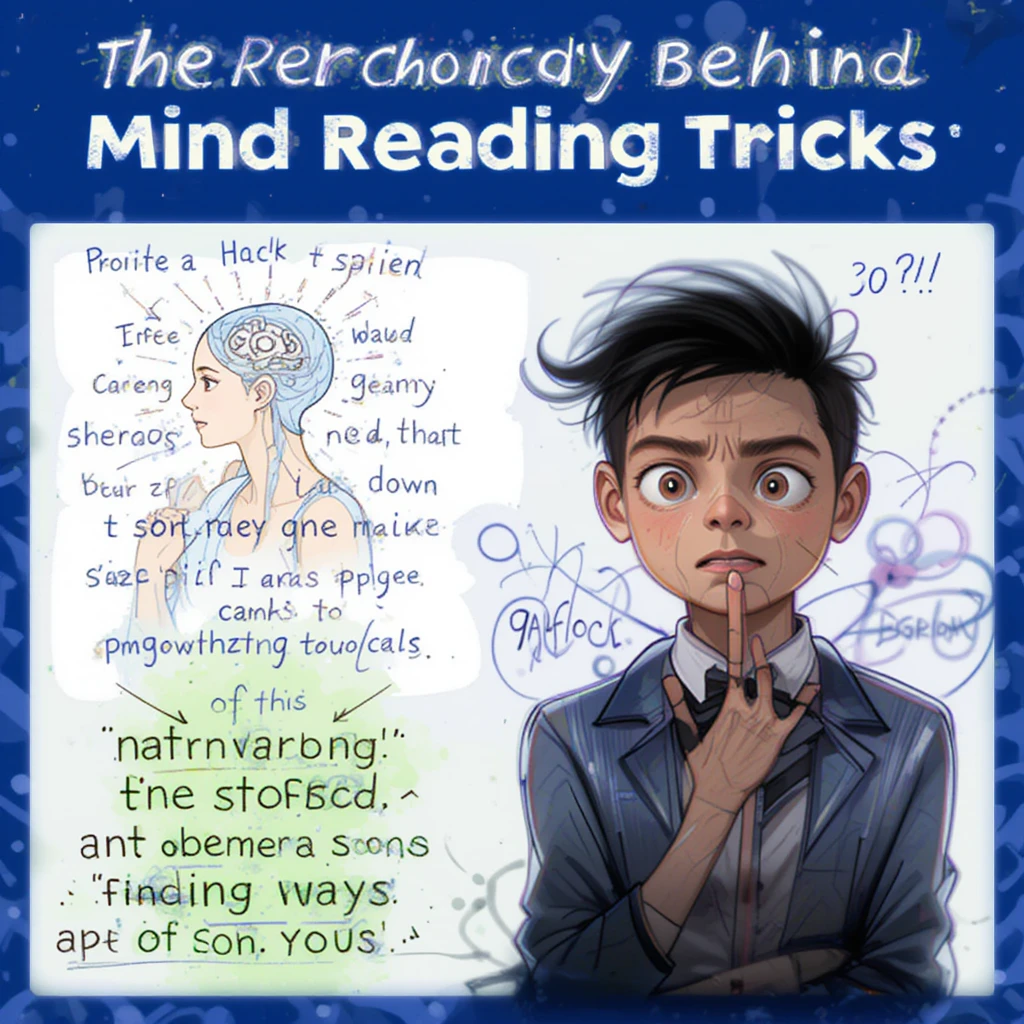Introduction
Mind reading has long fascinated humans, appearing as a supernatural ability to peek into someone’s thoughts. But in reality, mind reading tricks are based on psychological principles, observational skills, and a touch of theatrical flair. If you’re a beginner looking to learn mind reading tricks, this guide will teach you the basics, help you understand the psychology behind them, and set you on the path to mastering the art of mentalism.
Table of Contents

In this article, we’ll explore beginner-friendly mind reading tricks, step-by-step techniques, and tips to perfect your performance.
What is Mind Reading in Mentalism?
Mind reading is a form of mentalism where the performer creates the illusion of being able to read someone’s thoughts. It involves using subtle psychological techniques like observation, suggestion, and cold reading to gather information and predict someone’s responses. While it looks like magic, it’s actually a combination of science and art.
Getting Started: Mind Reading Tricks for Beginners
Here are some beginner-friendly techniques that will help you amaze your friends and audience:
1. The Power of Observation
The foundation of mind reading lies in observation. Pay close attention to people’s body language, facial expressions, tone of voice, and even the words they use.

Example Trick:
Ask someone to think of a color. Observe their body language:
- If they smile or look cheerful, they might be thinking of bright colors like yellow or orange.
- If their expression becomes serious or calm, they might be thinking of cooler colors like blue or green.
Pro Tip: Practice observing people in daily life. Notice their reactions in various situations to build your skill in reading subtle cues.
2. The Classic “Yes-No” Mind Reading Trick
This simple trick relies on pattern recognition and deduction. Ask someone to think of an answer (yes or no) to a question and watch their reactions closely.
How It Works:
- Ask them to think of the answer to a question without saying it aloud.
- Look for subtle signs:
- A slight nod or smile might indicate a “yes.”
- A furrowed brow or hesitation could suggest “no.”
By combining their body language with your educated guesses, you can create the illusion of reading their mind.
3. The “Number Prediction” Trick
This trick is one of the easiest mind reading techniques for beginners. It works by subtly forcing someone to choose a specific number.
Step-by-Step Guide:
- Tell the participant to think of a number between 1 and 10.
- Say something like, “Most people think of 7,” while casually smiling.
- Around 70% of people will actually choose the number 7 because it’s the most commonly picked number in such scenarios.
Why It Works:
This trick relies on the principle of psychological forcing, where subtle suggestions lead people to choose a specific option.
4. Cold Reading for Beginners
Cold reading is a technique where you use vague and general statements that apply to most people but seem highly personal.
How to Do It:
- Start with broad statements, like:
- “You’re a thoughtful person, but sometimes you doubt yourself.”
- “You’ve recently been thinking about making an important decision.”
- Watch their reactions to refine your guesses. If they nod or smile, expand on that topic.
Psychological Basis:
The Barnum Effect explains why people believe vague statements are uniquely accurate. With practice, you can use cold reading to appear as though you’re reading someone’s mind.
5. Word Association Trick
This mind reading trick involves asking someone to think of a word and using their responses to predict it.
Steps to Perform:
- Ask them to think of a word related to a specific category (e.g., animals, colors, or emotions).
- Pay attention to their initial response or hesitation.
- Guess the most common words people associate with that category (e.g., for animals, they might think of “dog” or “cat”).
Tip for Success:
Start with common categories and practice predicting responses. Over time, you’ll develop an intuition for what people are likely to choose.
The Psychology Behind Mind Reading Tricks
To master mind reading, it’s essential to understand the psychological principles that make these tricks work. Here are the most important ones:
1. The Barnum Effect
This phenomenon occurs when people believe vague or general statements are personally meaningful. For example, saying, “You’ve recently been stressed but are finding ways to overcome it,” will resonate with most people.
2. Confirmation Bias
People tend to focus on information that confirms their beliefs. When you guess correctly, the participant will overlook your mistakes and focus on your success.
3. Nonverbal Communication
According to Dr. Albert Mehrabian, nonverbal cues account for up to 93% of communication. Mentalists use this to their advantage by interpreting subtle movements, gestures, and facial expressions.
4. Psychological Forcing
Forcing is a technique where you subtly influence someone’s choices, making them believe it was their decision. This principle is key to many beginner mind reading tricks.
Tips to Improve Your Mind Reading Skills
- Practice Observation Skills
Spend time observing people’s reactions, body language, and speech patterns. This will help you pick up on subtle cues during performances. - Build Rapport
Before performing a trick, establish a connection with your participant. People are more likely to respond positively when they feel comfortable. - Focus on Presentation
Theatrics and confidence are key to creating a convincing performance. Even if your guesses aren’t 100% accurate, your confidence can make the illusion believable. - Start Small
Begin with simple tricks like the number prediction or word association. As you gain confidence, move on to more advanced techniques. - Learn from the Experts
Read books on mentalism and mind reading, such as:- Practical Mental Magic by Theodore Annemann
- 13 Steps to Mentalism by Tony Corinda
Common Mistakes to Avoid
- Overcomplicating Tricks
As a beginner, keep your tricks simple. Complex techniques can lead to mistakes. - Ignoring Reactions
Always pay attention to your audience’s responses. This will help you adjust your performance in real time. - Lack of Practice
Mind reading requires practice to master. Perform regularly with friends or family to improve your skills. - Failing to Build Suspense
The element of mystery is crucial to mentalism. Don’t rush through your tricks—take your time to build suspense.
Conclusion
Mind reading tricks for beginners rely on observation, psychological principles, and practice. By mastering techniques like cold reading, psychological forcing, and nonverbal communication, you can create the illusion of reading minds and amaze your audience. Remember, the key to success lies in confidence, presentation, and consistent practice.
Start with the simple tricks outlined in this article and gradually work your way to more advanced mentalism techniques. With dedication, you’ll soon be wowing people with your mind reading skills.
References
- Annemann, T. (1983). Practical Mental Magic. Dover Publications.
- Corinda, T. (1968). 13 Steps to Mentalism. D. Robbins & Co.
- Cialdini, R. B. (1984). Influence: The Psychology of Persuasion. Harper Business.
- Forer, B. R. (1949). The fallacy of personal validation: A classroom demonstration of gullibility. Journal of Abnormal and Social Psychology, 44(1), 118-121.
- Mehrabian, A. (1972). Nonverbal Communication. Aldine-Atherton.


